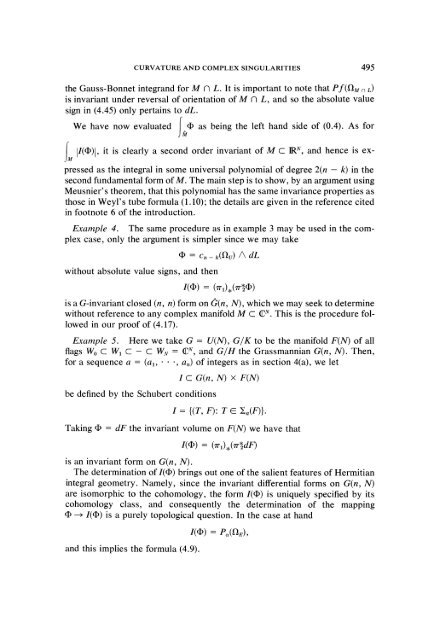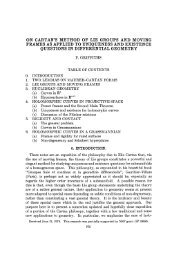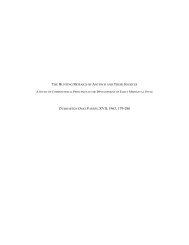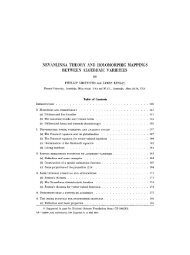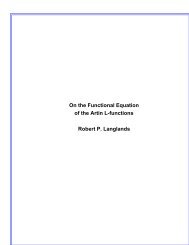View PDF - Project Euclid
View PDF - Project Euclid
View PDF - Project Euclid
You also want an ePaper? Increase the reach of your titles
YUMPU automatically turns print PDFs into web optimized ePapers that Google loves.
CURVATURE AND COMPLEX SINGULARITIES 495<br />
the Gauss-Bonnet integrand for M N L. It is important to note that Pf(fl c L)<br />
is invariant under reversal of orientation of M C) L, and so the absolute value<br />
sign in (4.45) only pertains to dL.<br />
We have now evaluated as being the left hand side of (0.4). As for<br />
/<br />
IM II()[, it is clearly a second order invariant of M C IRN, and hence is expressed<br />
as the integral in some universal polynomial of degree 2(n k) in the<br />
second fundamental form of M. The main step is to show, by an argument using<br />
Meusnier’s theorem, that this polynomial has the same invariance properties as<br />
those in Weyl’s tube formula (1.10); the details are given in the reference cited<br />
in footnote 6 of the introduction.<br />
Example 4. The same procedure as in example 3 may be used in the complex<br />
case, only the argument is simpler since we may take<br />
without absolute value signs, and then<br />
P c,_ (lv) / dL<br />
I() (Trl).(Tr*)<br />
is a G-invariant closed (n, n) form on 0(n, N), which we may seek to determine<br />
without reference to any complex manifold M C u. This is the procedure followed<br />
in our proof of (4.17).<br />
Example 5. Here we take G U(N), G/K to be the manifold F(N) of all<br />
flags Wo WI C WN N, and G/H the Grassmannian G(n, N). Then,<br />
for a sequence a (al, ", a,) of integers as in section 4(a), we let<br />
be defined by the Schubert conditions<br />
I G(n, N) F(N)<br />
I {(T, F): T a(F)}.<br />
Taking dF the invariant volume on F(N) we have that<br />
I() (Trl),(Tr*dF)<br />
is an invariant form on G(n, N).<br />
The determination of I() brings out one of the salient features of Hermitian<br />
integral geometry. Namely, since the invariant differential forms on G(n, N)<br />
are isomorphic to the cohomology, the form I() is uniquely specified by its<br />
cohomology class, and consequently the determination of the mapping<br />
I() is a purely topological question. In the case at hand<br />
and this implies the formula (4.9).<br />
I() P(f),


